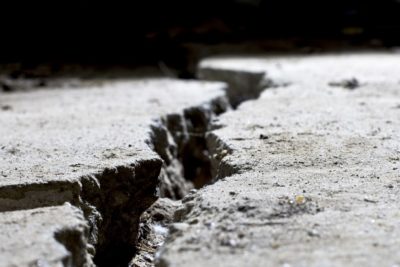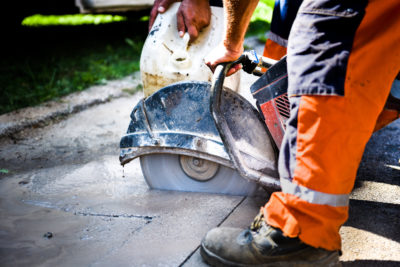There are various ways to approach a project regarding concrete sawing. This article will focus on diamond wire cutting, the most effective way to cut through concrete.
Before we dive in, though, we need to break down the basics.
Why Saw-Cut Concrete?
Saw cuts are made in concrete to create control joints. These joints help control cracked areas that occur due to shrinkage. The timing, as well as spacing, of saw cuts, is critical.
When to Saw-Cut Concrete
Determining when to saw concrete is based on the concrete’s exact mix and hardness, the type of cutting equipment used, as well as weather conditions.
The process of saw cutting usually begins from three to six hours after the concrete is poured, as far as weather conditions allow.
Concrete Sawing Methods
Essentially, there are two methods to use when sawing concrete.
Dry Sawing
Dry sawing is a concrete cutting method characterised by enormous amounts of dust. This approach is used mainly by contractors for large-scale outdoor projects. Often, a diamond blade is used for dry sawing since this blade doesn’t overheat in the absence of water. A diamond saw also minimises dust buildup.
Wet Sawing
Wet sawing is a sawing method characterised by its environmental friendliness. As opposed to dry sawing, this method results in significantly smaller amounts of harmful dust because water is used in the process. The blade remains cool and wet, which minimises the production of dust.
What is Concrete Hand Sawing?
Hand sawing is a term describing the use of handheld saws in the process of concrete sawing. Typically, you’ll take the hand sawing approach for more minor cuts and openings where wall saws or slab saws are impractical.
What Are The Different Handheld Saw Types?
- Electric saws, gas, and hydraulic cut-off saws
- Gas and hydraulic ring saws
- Gas and hydraulic chain saws
- Wire saws
Concrete Sawing Types and Techniques
There are several sawing types and techniques of which to take note, including:
Wire Sawing
Wire saws are designed to cut steel and reinforced concrete. Because these saws often contain diamond embedded cables used to create small holes and openings in the concrete, they offer tremendous flexibility to contractors by minimising wastage. Also, since wire sawing is an anti-vibration technique, it does not result in cracks of any kind around the openings created. Wire sawing, you’ll soon discover, has various benefits.
Floor Sawing
Floor saws are specifically designed to make precise cuts on flat surfaces, like roads or concrete slabs and floors.
Wall Sawing
Wall sawing makes cuts on vertical structures made of heavily reinforced concrete. Also referred to as track saws, these tools are mainly used in construction projects to create openings for doors and windows.
Ring and Chain Sawing
Ring and chain saws are handheld power saws generally used to execute small and medium-sized concrete sawing projects. Ring sawing is quite similar to chainsawing, and contractors prefer these techniques to make holes and openings in confined spaces.
What is a Diamond Wire Saw?
You may have a few questions regarding diamond wire saws, and we have the answers. Let’s get down to business.
What is Diamond Wire Used for?
Since diamonds are the hardest of all materials, they work like a charm in construction. Diamond wire saws are the best of all concrete saws! Here’s why.
Can Diamond Wire Cut Steel?
Diamond wire cutting uses wire embedded with abrasive (and, sometimes, synthetic) diamond dust to cut through steel, concrete and natural stone materials like granite. Typically lubricated and cooled using oil and water, diamond wire saws use abrasion to cut slabs instead of the usual saw teeth.
The wire consists of a single strand or numerous strands braided together to form a cable. Single-strand saws can be made abrasive by bonding synthetic diamond dust directly to the line or threading diamond-ingrained beads into the cable. Wire saws are classified as either continuous or oscillating, and the wire itself may be referred to as a “blade.”
How Does a Diamond Wire Saw Work?
As we’ve briefly mentioned, the diamond wire saw cutter uses abrasion instead of saw teeth to cut through concrete and other hard materials. The hardness of diamonds allows the abrasion technique to cut through almost any material softer than the “blade”.
The process of diamond wire cutting also produces less wastage than its conventional counterparts. Furthermore, it allows circular cutting on all sides, which prevents the wire from pinching. This makes diamond wire cutting an acutely effective construction tool!
Why Use a Diamond Wire Saw?
Here are the top 5 benefits of using a diamond wire saw:
1. Efficiency
Diamond wire cutting is known for the speed at which the concrete saws cut through any material. Consequently, this technique speeds up projects and requires fewer hands to manage the procedure.
2. Accuracy
Even in confined spaces, this technique makes fewer mistakes than any other. Its accuracy is unmatched!
3. Flexibility
Diamond wire cutting works in a variety of environments. For example. diamond wire sawing can be performed underwater where concrete, pipes, and other metal components must be cut or maintained. Additionally, diamond wire saws never compromise or weaken any surrounding structures.
4. Cutting Depth
From reinforced rebar to solid steel, diamond wire saws slice through almost any material. The incomparable precision and power of a diamond wire saw ensure that large materials become easy to handle. Thanks to the innovative process of diamond wire cutting, bridges, beams, columns, and other structures are much easier to build and maintain.
5. Environmental Impact
Diamond wire saws don’t produce dust or scatter debris. That’s why this technique is favourable to environmentalists and businesses aiming to achieve sustainability. Moreover, diamond wire cutting ensures minimal air pollution, noise, and material wastage.
Need help?
A specialist in our field, we can help you with your questions and diamond wire cutting needs!



